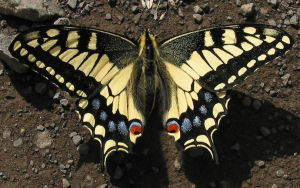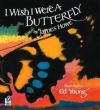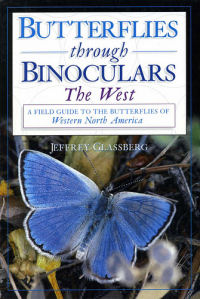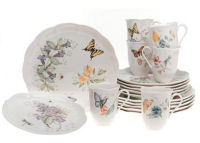
HOME
INTRO
SYMBOLS
ALMANAC
ECONOMY
GEOGRAPHY
STATE MAPS
PEOPLE
FORUM
NEWS
COOL SCHOOLS
STATE QUIZ
STATE LINKS
BOOK STORE
MARKETPLACE
NETSTATE.STORE
NETSTATE.MALL
GUESTBOOK
CONTACT US


Oregon State Insect

State insect: Oregon swallowtail
© Fred Ramsey
The Oregon swallowtail butterfly was adopted as the Oregon's official insect with the approval of Senate Concurrent Resolution No. 6 by the Oregon Legislature.
A true native of the Northwest, the Oregon Swallowtail is at home in the lower sagebrush canyons of the Columbia River and its tributaries, including the Snake River drainage. This strikingly beautiful butterfly, predominantly yellow, is a wary, strong flier not easily captured.
60TH OREGON LEGISLATIVE ASSEMBLY--1979 Regular Session
Senate Concurrent Resolution No. 6
WHEREAS, insects represent by far the largest group of living organisms; and
WHEREAS, the recognition of a state insect would further educate by promoting a greater interest and understanding of entomology; and
WHEREAS, insects have survived well in the face of exploding population and remain a major area of nature study left available to young and old alike; and
WHEREAS, the Oregon swallowtail butterfly (papilio Oregonius) is indigenous to the Oregon territory, contains the word "Oregon" in its common and scientific names, is of great aesthetic value and has no objectionable qualities; now, therefore,
BE IT RESOLVED BY THE LEGISLATIVE ASSEMBLY OF THE STATE OF OREGON:
That the Legislative Assembly adopt the Oregon swallowtail butterfly (papilio Oregonius) as Oregon's official insect to join the beaver, the chinook salmon, the Oregon grape, the Douglas fir, the western meadowlark and the thunderegg as unique symbols of Oregon's distincitve history and environment.
Filed in the Office of the Secretary of State July 17, 1979.
Oregon Law
The following information was excerpted from the Oregon Revised Statutes - 2009 Edition, Title 19, Chapter 186.
TITLE 19 MISCELLANEOUS MATTERS RELATED TO GOVERNMENT AND PUBLIC AFFAIRS
186. State Emblems; State Boundary
CROSS-REFERENCES.
Swallowtail butterfly declared to be official insect, SCR 6 (1979)
Sources...
State of Oregon. Oregon Revised Statutes - 2009 Edition. Salem: State of Oregon, 2011. Web. 8 Apr 2011. <http://www.leg.state.or.us/ors/home.htm>.
Shearer, Benjamin F. and Barbara S. State Names, Seals, Flags and Symbols: A Historical Guide Third Edition, Revised and Expanded. Westport, Conn: Greenwood Press, 3 Sub edition, 2001.
Additional Information
Oregon Swallowtail (Papilio oregonius) :
Oregon Department of Fish and Wildlife Fact Sheet.
:
Oregon Department of Fish and Wildlife Fact Sheet.
Papilio machaon oregonia W. H. Edwards, 1876 ("Oregon" Swallowtail): Butterflies of America.
Papilio machaon oregonius - (Edwards, 1876), Oregon Swallowtail: A network connecting science with conservation - NatureServe Explorer: An Online Encyclopedia of Life.
Papilio machaon oregonius (W. H. Edwards, 1876): Integrated Taxonomic Information System (ITIS) Here you will find authoritative taxonomic information on plants, animals, fungi, and microbes of North America and the world.
State insects: Complete list of official state insects from NETSTATE.COM.
More symbols & emblems: Complete list of official Oregon state symbols from NETSTATE.COM.

Where Butterflies Grow
Joanne Ryder
Where Butterflies Grow, by Joanne Ryder, 32 pages. Puffin (June 1, 1996) Reading level: Ages 4-8. In a field of lacy leaves, a small caterpillar hatches, grows, and sheds its skin, becoming a smooth, green creeper. It eats and changes some more, then in a sequence of remarkable close-ups, spins a sliken sling in which to pupate--until it finally bursts forth as a brilliant black swallowtail butterfly. Includes suggestions on how children can grow butterfiles in their own gardens.

I Wish I Were
a Butterfly
James Howe
I Wish I Were a Butterfly, by James Howe. 40 pages. Voyager Books (February 28, 1994) Reading level: Ages 4-8. After the frog at the pond's edge tells him that he's ugly, the cricket of Swampswallow Pond loses his zest for life and for singing. The glowworm and the ladybug try to persuade the cricket that he's just as good as the rest of them, while the dragonfly declares, "Wishing is a waste of time." Finally, the Old One, a spider who lives on the other side of the pond, spins a wise tale about the real beauty of friendship and convinces the cricket to sing again. A simple fable that deserves to stay in print a long, long, time.
Peterson First Guide to Butterflies and Moths, by Paul A. Opler, edited by Roger Tory Peterson. 128 pages, Houghton Mifflin Harcourt; 2nd edition (February 20, 1998) Peterson First Guides are the first books the beginning naturalist needs. Condensed versions of the famous Peterson Field Guides, the First Guides focus on the animals, plants, and other natural things you are most likely to see. They make it fun to get into the field and easy to progress to the full-fledged Peterson Guides.

The Butterfly Book
Kersten Hamilton
The Butterfly Book: A Kid's Guide to Attracting, Raising, and Keeping Butterflies, by Kersten Hamilton. 40 pages. Avalon Travel Publishing; 1st edition (March 26, 1997. Reading level: Ages 9-12. An introduction to the life cycle, food, habitat, and behavior of butterflies shares advice on butterfly observation and conservation, explaining how to design a garden to attract butterflies and offering a color identification guide to twenty common North American butterflies.

Butterflies Through Binoculars-The West
by Jeffrey Glassberg
Butterflies through Binoculars: The West, by Jeffrey Glassberg. 384 pages, Oxford University Press, USA (July 26, 2001) Featuring an extensive array of photographs, this field guide offers a comprehensive display of all the magnificent butterflies of the western region, stretching from the plains of middle America to the Pacific coast, and from southwestern Canada all the way to the Hawaiian islands. From butterfly biology to butterfly conservation, this useful and practical field guide provides all the necessary information to make your butterfly experience a success.
National Audubon Society Field Guide to North American Butterflies, 928 pages. Knopf; Chanticleer Press ed edition (July 12, 1981) A handy field guide with more than 1,000 photographs of all the butterflies of North America north of Mexico, including all true butterflies, the most common skippers, and many migrants and strays. The color plates are visually arranged by shape and color, and thumb-tab silhouettes provide a convenient index to identification of butterflies in the field. The species account for each butterfly provides measurements, descriptions of each stage of the life cycle, and information on coloring or distinguishing markings, flight period, habitat, and range.
A Field Guide to Western Butterflies, by Paul A. Opler. 512 pages. Houghton Mifflin Harcourt; Rev Sub edition (May 15, 1998) Includes more than 590 species, illustrated in lifelike positions on beautiful new color plates. With descriptions of all the butterflies that occur west of the 100th meridian in the United States and Canada, this guide has accurate information on ranges, habitats, flight seasons, food plants, and more. Brand-new color range maps and more than 100 color photographs accompany the species descriptions.
The Life Cycles of Butterflies: From Egg to Maturity, by Judy Burris and Wayne Richards. 160 pages. Storey Publishing, LLC (April 1, 2006) This book describes in text and photos the butterflies that commonly visit gardens in the eastern states. Beginning with a chapter that looks at the basics of butterfly egg laying, the growth of caterpillars, metamorphosis, and butterfly behavior, the authors move to the heart of the book. With exquisite close-up photography, the eggs, caterpillars, chrysalids, and adults of 23 well-known butterflies are revealed.
Attracting Butterflies & Hummingbirds to Your Backyard, by Sally Roth. 304 pages. Rodale Books (October 24, 2002) If you have never read one of Ms. Roth's books you are in for a real treat. Her writing style is wittily informative which makes us enjoy our lessons. She not only teaches us which plants to use in our gardens to attract both these winged wonders, but how to create the kinds of gardens they prefer. Shelter, water, host plants for butterfly caterpillars, and even fruit feeders and hibernating boxes are among the topics within these pages.
Stokes Butterfly Book: The Complete Guide to Butterfly Gardening, Identification, and Behavior, by Donald & Lillian Stokes, Ernest Williams. 96 pages, Little, Brown and Company; 1st edition (October 17, 1991) This popular guide to attracting, identifying, and enjoying all the common North American species of butterflies includes 149 full-color photos, 65 range maps, and two sample garden plans.

Lenox Butterfly Meadow
Lenox Butterfly Meadow Tableware Collection, Summer teas and spring brunches call for dinnerware as fresh and lovely as the weather. The Lenox Butterfly Meadow pattern features a garden motif of butterflies, bumblebees, ladybugs, and blossoms set against an ivory background. The delicately rendered images, created by Lenox artist Louise Le Luyer, vary between pieces for a charmingly playful table. Crafted from fine bone porcelain, the pattern has gently scalloped rims and is safe in the oven, microwave, and dishwasher. Like all Lenox dinnerware, the Butterfly Meadow line is covered by a lifetime replacement policy.

